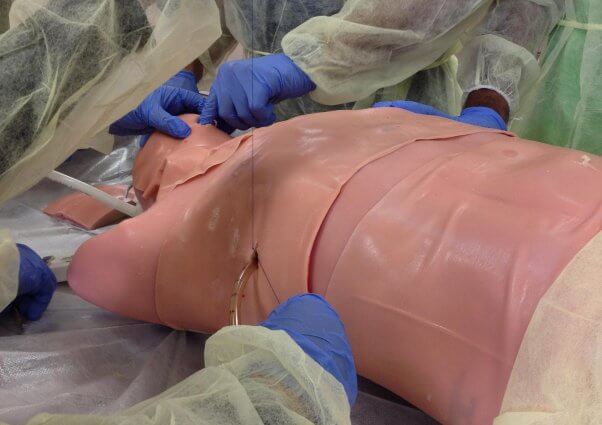Is There Ways To Test A Space Ship Other Than With Animal Piolets
During a regime meeting almost funding for enquiry, former U.South. National Institutes of Health director Dr. Elias Zerhouni admitted to his colleagues that experimenting on animals to help humans has been a major failure:
"We take moved away from studying homo disease in humans. … Nosotros all drank the Kool-Aid on that one, me included. … The problem is that [animal testing] hasn't worked, and information technology's time nosotros stopped dancing effectually the trouble. … We need to refocus and suit new methodologies for use in humans to understand disease biology in humans." —Dr. Elias Zerhouni
Today—because experiments on animals are roughshod, fourth dimension-consuming, and generally extraneous to humans—the world's most frontward-thinking scientists are developing and using animal-free methods that are actually relevant to human being health for studying diseases and testing products. These alternatives to animal testing include sophisticated tests using human cells and tissues (likewise known equallyin vitro methods), advanced estimator-modeling techniques (frequently referred to asin silico models), and studies with man volunteers. These and other non-animate being methods are not hindered by species differences that brand applying beast test results to humans difficult or impossible, and they usually accept less time to complete.
PETA and our affiliates fund the development of many of these alternatives to animal testing, vigorously promote their use to governments and companies around the world, and publish research on their superiority to traditional animal tests.
Here are only a few examples of the numerous country-of-the-art, not-brute methods bachelor and their demonstrated benefits:
In Vitro Testing
- Researchers have created "organs-on-fries" that incorporate human being cells grown in a land-of-the-art system to mimic the structure and function of homo organs and organ systems. The chips tin can be used instead of animals in illness research, drug testing, and toxicity testing and have been shown to replicate human physiology, diseases, and drug responses more accurately than rough fauna experiments practise. Some companies, such as AlveoliX, MIMETAS, and Emulate, Inc., take already turned these chips into products that other researchers can use in place of animals.
- A variety of cell-based tests and tissue models tin be used to assess the safety of drugs, chemicals, cosmetics, and consumer products. For case, MatTek Life Sciences' EpiDerm™ Tissue Model is a 3-dimensional, human cell–derived model that tin can be used to replace rabbits in painful, prolonged experiments that accept traditionally been used to evaluate chemicals for their ability to corrode or irritate the pare.
- The PETA International Scientific discipline Consortium Ltd. helped fund the development of MatTek Life Sciences' EpiAlveolar, a first-of-its-kind 3-dimensional model of the deepest part of the human lung. The model, equanimous of human cells, can be used to study the effects of inhaling dissimilar kinds of chemicals, pathogens, and (due east-)cigarette smoke.
- Devices made by High german-based manufacturer VITROCELL are used to expose human being lung cells in a dish to chemicals in club to test the health effects of inhaled substances. Every solar day, humans inhale numerous chemicals—some intentionally (such every bit cigarette smoke) and some inadvertently (such as pesticides). Using the VITROCELL machines, human cells are exposed to the airborne chemical on one side while receiving nutrients from a blood-like liquid on the other—mimicking what actually occurs when a chemical enters a human lung. These devices, too every bit EpiAlveolar, can replace the electric current method of confining rats to tiny tubes and forcing them to inhale toxic substances for hours before they are eventually killed.
- Researchers developed tests that use human blood cells to detect contaminants in drugs that cause a potentially dangerous fever response when they enter the torso. The not-animal methods supercede the crude methods of bleeding horseshoe venereal or restraining rabbits, injecting them with drugs or extracts from medical devices, and taking their temperature rectally to monitor if they develop a fever.
- Through research funded past the PETA International Science Consortium Ltd. and carried out at the Establish for Biochemistry, Biotechnology and Bioinformatics at the Technische Universität Braunschweig in Germany, scientists created fully human being-derived antibodies capable of blocking the poisonous toxin that causes diphtheria. This method can end the practice of injecting horses repeatedly with the diphtheria toxin and draining huge amounts of their blood in order to collect the antibodies that their allowed systems produce to fight the disease.

Computer (in Silico) Modeling
- Researchers accept developed a wide range of sophisticated computer models that simulate human biology and the progression of developing diseases. Studies bear witness that these models tin can accurately predict the ways that new drugs will react in the homo body and supersede the utilise of animals in exploratory enquiry and many standard drug tests.
- Quantitative structure-activeness relationships (QSARs) are computer-based techniques that can replace brute tests by making sophisticated estimates of a substance'south likelihood of being chancy, based on its similarity to existing substances and our knowledge of human biology. Companies and governments are increasingly using QSAR tools to avert testing chemicals on animals.
Research With Human Volunteers
- A method called "microdosing" tin provide vital information on the rubber of an experimental drug and how it is metabolized in humans prior to large-scale human being trials. Volunteers are given an extremely small one-time drug dose, and sophisticated imaging techniques are used to monitor how the drug behaves in the body. Microdosing tin can replace certain tests on animals and help screen out drug compounds that won't work in humans and so that they are never tested in animals.
- Advanced brain imaging and recording techniques—such as functional magnetic resonance imaging (fMRI)—with homo volunteers can be used to replace archaic experiments in which rats, cats, and monkeys have their brains damaged. These mod techniques allow the homo brain to be safely studied down to the level of a single neuron (equally in the case of intracranial electroencephalography), and researchers can even temporarily and reversibly induce encephalon disorders using transcranial magnetic stimulation.
Homo-Patient Simulators

This advanced TraumaMan simulator was donated by PETA to supervene upon the utilize of animals for Advanced Trauma Life Support training.
- Strikingly lifelike computerized human-patient simulators that exhale, drain, quake, talk, and even "die" have been shown to teach students physiology and pharmacology better than rough exercises that involve cutting up animals. The most loftier-tech simulators mimic illnesses and injuries and give the appropriate biological response to medical interventions and medication injections. All medical schools across the U.S., Canada, and India accept completely replaced the utilise of animal laboratories in medical preparation with simulators as well every bit virtual reality systems, calculator simulators, and supervised clinical experience.
- For more avant-garde medical grooming, systems similar TraumaMan—which replicates a breathing, haemorrhage human torso and has realistic layers of peel and tissue, ribs, and internal organs—are widely used to teach emergency surgical procedures and have been shown in numerous studies to impart lifesaving skills ameliorate than courses that require students to cut into alive pigs, goats, or dogs.
Although scientists accept state-of-the-fine art, constructive, non-creature methods available, experimenters continue to torture countless animals anyhow. "Without Consent," PETA'southward interactive timeline, features almost 200 stories of twisted experiments from the past century, including ones in which dogs were forced to inhale cigarette smoke for months, mice were cut upward while withal conscious, and cats were deafened, paralyzed, and drowned. Visit "Without Consent" to learn about more harrowing animal experiments throughout history and how you tin can assistance create a amend time to come for living, feeling beings.
Without Consent
Donate now to help cease creature tests!
Source: https://www.peta.org/issues/animals-used-for-experimentation/alternatives-animal-testing/
Posted by: henselpaing1953.blogspot.com

0 Response to "Is There Ways To Test A Space Ship Other Than With Animal Piolets"
Post a Comment